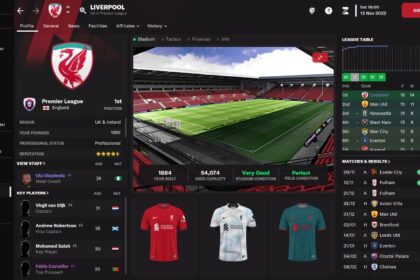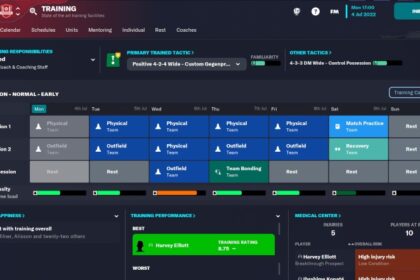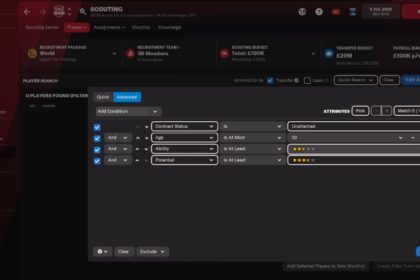The tactic creator in Football Manager has come a long way since the days of sliders and adding forward, backward and lateral arrows to the formation screen!
It’s now much more intuitive and grounded in real-world footballing theories and terminology, and as a result, you can take your ideas and apply them more easily within the game.
However, the process can be daunting to newcomers, while even more familiar players may still be frustrated with a lack of success in translating their particular ideas into the match engine.
For these reasons, the game’s custom presets, as well as downloadable tactics, remain very popular. However, understanding certain basic tactical principles in FM23 should help you with developing your own tactics.
To help with that, I have put together this guide to the best tactics for FM23. I have also broken down some basic principles of creating tactics from your own ideas.
Defensive Tactics
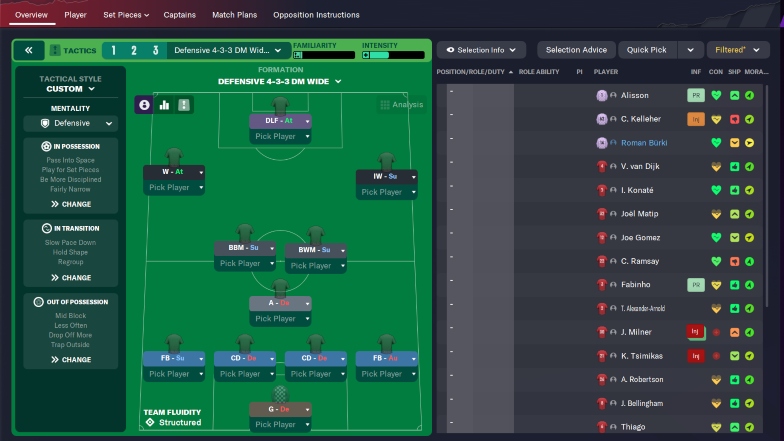
In more recent iterations of FM, managers have often struggled to implement a more defensive approach, where they employ a low block, try to absorb pressure, and hit teams on the break.
In FM23, it has been promised that defensive systems will be a more viable tactical philosophy. So, let’s take a look at some tactical ideas for those of you who want to implement a deep, counter-attacking approach.
Formations
The 4-3-3 DM Wide is one of the most commonly used defensive formations in FM.
It maintains good coverage of the width of the pitch while utilizing a player in the DM slot to screen the defense and cover for other more high-pressing midfielders.
However, employing one striker upfront can make counterattacks less potent, so a 4-4-2, 3-5-2, and 4-1-3-2 can all be used in more aggressive defensive systems.
Tactical Instructions
Selecting a defensive mentality will cause your players to sit deeper and narrower, standoff more and focus on protecting the space between the ball and the goal, rather than closing players down and leaving space available in more dangerous areas. You can then use team and player instructions to offset some of these low-risk behaviors.
For example, tight marking will make it harder for the opposition to find passing options. This is a higher-risk instruction, but since you are sitting deeper with lots of players in the defensive third, you don’t have to worry as much about a player losing their marker and finding space, as there’s less of it available.
Other examples of offsetting a defensive mindset include tackling harder and/or having the odd player close down more. If you compound a defensive mentality with additional low-risk instructions, you may end up being too passive without the ball. After all, you need turnovers via tackles or interceptions to launch counterattacks.
As with team instructions, offsetting the lower mentality with support and attack duties will ensure some of your players are willing to take some risks with their passing, dribbling, forward runs, etc.
A defend duty will not make a player defend better, just more passively and they are less likely to be caught out of position when they lose the ball. So don’t assume a defensive tactic needs defend duties all over the pitch.
A common mistake among managers is trying to protect a lead late in a game by switching to a defensive mentality, while still having 4 or 5 very attack-minded players on the pitch. In this case, you’re essentially inviting pressure onto a defense that isn’t very good at defending.
In this scenario, you have the option of using possession as a defensive tool. With a defensive mentality, you will be winning the ball less often, so looking after it when you have it will make better use of the players you have on the pitch and prevent your defense from coming under as much pressure.
Suitable Player Types
Whatever your tactical approach, it is absolutely imperative that you have players who are capable of pulling it off. A sound, well-thought-out tactic can fall apart completely if the wrong types of players are asked to implement it.
For example, a direct approach with a mediocre target man and average-paced wingers will simply turn over the ball again and again due to lost headers and failed passes into space.
Such an approach must prioritize attackers and attacking midfielders with great physical attributes and the will to fight for the ball.
If you don’t have all the players you need to implement your ideas, the transfer market should be your best friend. A good FM23 scouting guide is a great way to get started on finding the right types of players for your dream squad.
In terms of the types of players that you’ll need for a defensive tactic, the attributes to look for in your players will be things like marking, anticipation, concentration, positioning, and teamwork. This will ensure they stick close to their opposite numbers, stay alert, read the game well, and function as a cohesive unit.
Your defenders will need to be strong in the air since you will be allowing the opposition into crossing positions. Mobility will be less important since you’re leaving little space in behind defenders and they’re not having to defend large areas of space, as they might have to in a high defensive line.
Midfielders and attackers with low teamwork and work rate will be liabilities in your team since they won’t track back as effectively.
There’s little point in fielding too many highly creative players either since you’ll be ceding possession and asking them to play without the ball more often. In possession, they’ll be asked to play safer anyway so they’ll rarely have the opportunity to use their technique, flair, vision, etc.
Limit these types of players to one or two but give them roles and duties that encourage them to take a few more risks, or you won’t be making use of what they’re actually good at!
In-game equivalents: direct counter, fluid counter, park the bus, catenaccio
Possession Tactics
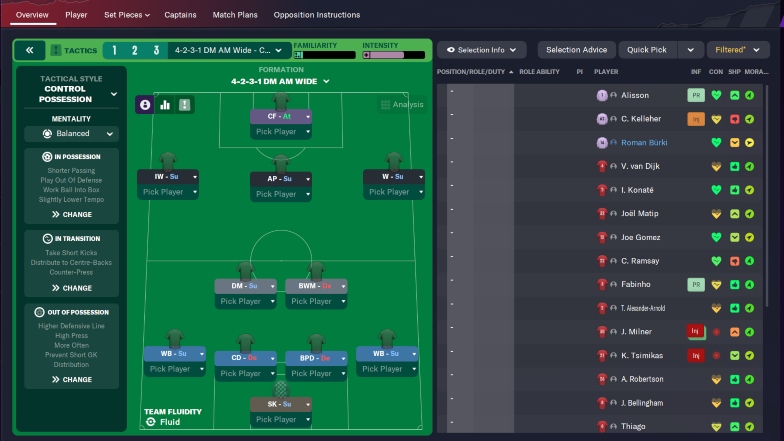
Systems that aim to dominate possession must either keep the ball exceptionally well or win it back at every opportunity, or both. Here we will focus on the former.
Formations
Formations suitable for possession football tend to be those that pack the center of the pitch, in order to make it easier to provide support to the ball carrier at all times. A 4-4-2 diamond, 4-1-3-2, or 4-3-1-2 all offer 4 central midfielders, who can drift over to support the right or left wings, as well as link the defense and attack. Even a 4-3-3 or 4-2-3-1 can dominate the middle of the pitch when the wide players are instructed to carry the ball into more central areas.
Tactical Instructions
Despite the fact that people tend to associate high possession tactics with attacking football, thanks to teams like Guardiola’s Barcelona and Manchester City scoring a lot of goals, playing possession football is actually a relatively low-risk approach.
You’ll notice that FM’s in-game ‘control possession’ tactic does not use an attacking mentality. Instead, it favors a balanced approach. This ensures players are more conservative on the ball, tempering their appetite for high-risk actions which may lead to turning over the ball.
When De Bruyne receives the ball, he is given instructions to be more creative, because that is what he excels at. If less capable players were given these instructions, they may be wasteful in possession, causing the whole system to break down. A role like an advanced playmaker with an attack duty would be a suitable choice to achieve this effect in FM.
Guardiola does, however, allow his players a degree of creative freedom to break from their tactical discipline when the moment is right. In FM, this is the equivalent of the be more expressive instruction.
Other features of a possession tactic include wide players carrying the ball inside (inverted wingers/fullbacks), rather than running wide and risking isolating themselves from support (wingers and wingbacks).
Overlapping partnerships are also common, where a more advanced player drops toward the ball and a deeper player makes the penetrating run beyond them. This can be achieved with support duties in more advanced positions and attack duties in deeper ones.
Suitable Player Types
Possession football can be a very demanding approach in terms of player attributes.
On the technical side, first touch, passing and technique are going to be absolutely essential for pretty much every player, but especially those in the middle of the park.
Mentally, players will need anticipation, composure, concentration, decisions, teamwork, off-the-ball, and vision.
This skill set will ensure players can move intelligently to make themselves available to receive the ball, quickly bring the ball under control, and then distribute it again intelligently, even when under intense pressure.
A possession tactic will break down very quickly if you can’t transition the ball into midfield, so it’s equally important to have as many of these attributes in your defenders too.
This will form the DNA of your team. Then you can look for other attributes on a more positional basis. After all, you still need to be able to defend, tackle, create and score!
In-game equivalents: control possession, tika-taka
Direct Tactics

Direct football is about getting the ball into attacking positions and ultimately into the back of the net with as minimal fuss as possible. It’s an approach that is often employed by less capable teams who want to make the most of a limited, but specific, set of attributes in their players.
From an FM perspective, both direct passing and balanced or more attacking team mentalities are suitable for this kind of system.
Direct passing increases the range within which players are given tactical license to play their passes, while higher mentalities encourage players to get the ball forward at speed, rather than prioritizing possession.
Formations
Formations that naturally have attackers positioned higher up the pitch are well suited to direct football, such as a 4-2-3-1 or a 4-2-4. This means players are in position to receive direct passes earlier in transitions before the opposition has a chance to fully regroup into their defensive shape.
Formations with 2-man striking partnerships, like the 4-4-2, 3-5-2, or 4-1-3-2 can also be effective options. The 4-4-2 is a more natural direct formation, as it is easier to stretch play horizontally, while the 3-5-2 and 4-1-3-2 are perhaps more suited to direct, counter-attacking systems.
Tactical Instructions
Roles that work best here include wingers who will receive passes and immediately look to carry the ball wide, take on their man and deliver a cross into the box. No fuss.
Target men to win headers, secure loose ball, and hold up play are essential for progressing your team up the pitch, and a pacey advanced forward looking for early passes in behind will be a constant threat to defenders if they can’t keep up.
Playmaking roles aren’t as well suited to direct systems, as they slow the progression of the ball, although a deep-lying playmaker pinging accurate long passes from deep can be effective.
Player partnerships in a direct system usually feature the more attack-minded player in the more advanced position. For example, an attack-duty winger ahead of a supporting full-back. Direct play is about penetrating space quickly with advanced runners receiving longer passes earlier in the build-up.
Direct football isn’t limited to less capable teams though. Some very good teams have also used the approach to great effect, such as Klopp’s early Liverpool sides that used a combative and mobile midfield to secure possession before quickly feeding the ball forward to their speedy wingers in lightning-quick transitions.
Suitable Player Types
Direct tactics work well with more one-dimensional teams because they focus on what the players are good at, and minimize the behaviors that they’re poor at. Physical attributes are therefore king.
Acceleration, agility, balance, and pace are essential for wingers and advanced forwards, while balance, jumping reach, and strength are key for a target man.
Throw in some stamina for your midfielders and you’ve got a team of athletes prepared to out-pace and out-muscle the best of them. Even a touch of natural fitness can help to make sure players can stave off injury and be ready to go again for the next match.
From a mental perspective, attributes like determination, teamwork, and work rate are good to look for throughout your team, while aggression and bravery will be important up front and in the central midfield.
Technical attributes are less important for this style of football, but some dribbling and crossing ability out wide, heading up front, and passing in the middle of the pitch wouldn’t go amiss.
In-game equivalents: wing play, route one, direct counter-attack
Attacking Tactics
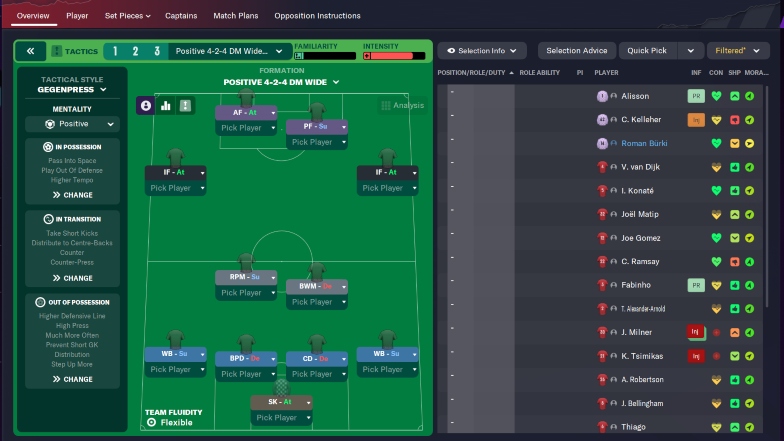
The main characteristic of attacking football is obviously goals, but from a style point of view, we’d normally associate it with high-pressing, high-tempo, high-risk football. In FM terms, it’s undoubtedly replicated using an attacking team mentality.
Attacking systems aren’t limited by their passing style, and can involve either direct or shorter passing. The former is a little easier to pull off with less capable players, while a high-tempo, short-passing system is very much the opposite.
More direct attacking systems will make use of more direct roles, such as wingers, shadow strikers, advanced forwards, and any other roles that look to carry the ball, stretch play and make lots of forward runs.
Shorter passing in an attacking tactic will likely feature roles like playmakers, inverted wingers, and inside forwards, who are all willing to take risks but also carry the ball centrally and link up using shorter passes, while also opening up space for adventurous wing backs to surge into.
Overlapping partnerships like this are a common feature of attacking systems, as they look to get men forward and overload opposition defenses.
Formations
In terms of formations, attacking football can work with any number of possibilities, so long as they are effective in getting men forward and occupying defenders right across the pitch. Direct attacking systems may favor a 4-3-2-1, 4-4-2, or 4-2-4, while a shorter passing approach may find a 4-3-3 or 4-3-1-2 more suitable.
Tactical Instructions
Attacking systems can be very flexible. They provide a chance to really have fun with all the roles available within the game.
Trequartistas, Registas, Segundo volantes, Complete forwards, and Complete wing backs. These are all aggressive roles that fit with the overall team mentality. Just be sure that your players can pull off such high-risk instructions.
The more aggressive roles you use, the better your team will need to be to avoid turning over the ball at every turn.
On the other hand, it can sometimes be a good idea to temper all those high-risk instructions with a few safer instructions too, in order to ensure the wrong players aren’t taking on the risky passes and flash dribbling skills.
Using the odd defend duty in a role that takes fewer risks and/or dribbles less allows you to deploy ball winners and defensive stalwarts within an attacking system, without them taking on the gung-ho mentality of their teammates.
Aggressive play with the ball can often be complemented by aggressive pressing and a high defensive line without it. Again, this is best used when you’re confident of being the better team and can apply relentless pressure on the opposition.
Suitable Player Types
Attacking football is a demanding style to pull off successfully, particularly if you want to play short, one-touch passing without gifting the ball to the opposition on a regular basis.
As a result, your players will need to be great all-rounders in an attacking sense. In possession, you’ll need players with first touch, passing, technique, anticipation, composure, concentration, decisions, flair, off-the-ball, teamwork, and vision. In addition, ball carriers will then need dribbling, acceleration, agility, balance, and pace.
If you plan on supporting your attacking ball play with aggressive ball winning as well, your players will need marking, tackling, aggression, bravery, determination, work rate, stamina, and strength.
Holding a high defensive line will also then require defenders with the intelligence (anticipation, composure, concentration, decisions, positioning, and teamwork) and mobility (acceleration, agility, pace) to defend all that open space.
As you can see, we’ve covered almost the whole spectrum of attributes, which gives you an idea of why such an expansive approach is usually reserved for exceptionally talented squads.
Switching to a more direct system may be suitable if you’re looking to play attacking football, but lack the all-round quality to pull it off at higher levels.
In-game equivalents: gegenpress, vertical tika taka
Understanding Tactical Principles in FM23

Any tactic, whatever the style, will need to include at least some of the following concepts in order to be successful. In possession of the ball, a tactic will need:
- Width – this is achieved using the instructions of either staying wider or running wide with the ball, or both. Even a tactic that plans to attack central areas will need width in order to stretch the defense and open up space in the middle.
- Depth – this is essentially stretching the play vertically, rather than horizontally, to open up space between the lines. This requires both runners into space behind the defense, as well as players in deeper positions to draw defenders forward and out of position.
Pushing everybody forward will just compress the space your players have to work in, making them easier to defend against. Players with the instructions get further forward and hold position to provide depth.
- Support – Players need passing options. It won’t always be possible to play the killer ball or run at the defense, so players need teammates in support to offer an easier pass. Support is best provided, unsurprisingly, by players with support duties!
- Penetration – Support allows teams to circulate the ball and keep possession, but scoring goals is the name of the game. For that, you will need players both carrying the ball and making forward runs into dangerous positions, as well as teammates willing to play the riskier passes to find them.
Attack duties and player instructions like get further forward, dribble more and take more risks are all ways of providing penetration.
- Defensive cover – When you’re in possession, you still need to prepare for the turnover and transition into a defensive shape. Having players in more conservative positions helps snuff out counterattacks, recover loose balls when attacks break down, and reset play for another attack.
As a bonus, they also provide depth in possession. Defend duties and the hold position instruction provide defensive cover.
- Chance creation – Every tactic needs somebody providing the ammunition. Instructions like take more risks, cross more often and be more expressive are all ways of giving players license to create.
- Chance conversion – There’s no point in creating chances if nobody is there to stick it in the net. Every tactic needs somebody attacking the box at every opportunity, whether that be an orthodox central striker or a wide player making diagonal runs.
Attack duties in advanced positions will provide the most consistent goal threat, while deeper attack duties, get further forward and certain player traits, like gets into opposition area, will be secondary options.
Out-of-possession, tactics need to include:
- Applying pressure – whatever the tactic, somebody needs to be closing down the player in possession at some point, and attempting to win the ball. Whether it’s high up the pitch or only once the opposition has entered your defensive third, if players are given time and space, they’ll hurt you.
Defend duties will be the most conservative with their pressing, while support and attack duties and the player instructions close down more and tackle harder will all encourage more aggressive defensive behavior.
- Providing cover – On the flip side, if one or more players are pressing the ball, someone else needs to hold their position to protect the space being vacated. If everybody closes down at once and the opposition evades the press, you leave yourself extremely vulnerable.
It’s all about balance. Defend duties, hold position, and close down less will all provide cover for pressing players.
- Remaining compact – You can’t defend the whole pitch at once, so you need to choose where you want to set your block: high, medium, or low?
Whatever you choose, your defensive line and your line of engagement need to remain close enough that you don’t open up too much space between the lines. Unfortunately, more complex approaches, like split blocks are difficult to implement in FM.
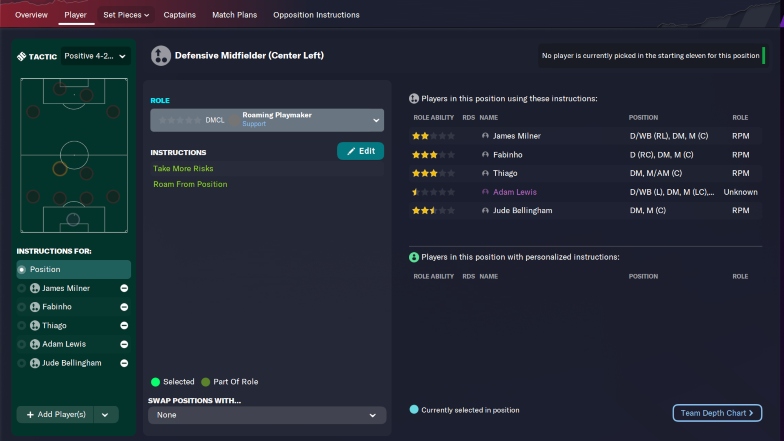
Whether you’re playing an attacking or defensive system, you will still need to moderate your players’ behavior to avoid too much or too little of a particular action.
This is where smart team/player instructions can make the difference and highlights the need to not overdo how many instructions are selected.
Team instructions should be used to add a little bit of variation to a tactic, offset the frequency of certain behaviors, and not double down on instructions already inherent within the mentality and roles chosen.
For example, if you’re playing with a high mentality and lots of adventurous roles, like playmakers, complete forwards, trequartistas, etc., do you really need pass into space and run at defense selected too?
This will only encourage the rest of the team to adopt similar behaviors, detracting from the players who are most well-suited to performing them. Basically, it’s overkill.
In this instance, it would be more suitable to include some safer, more conservative roles and instructions. Too many high-risk instructions may lead to your team bypassing your most creative players, or simply losing the ball.
Final Words
Remember, the team mentality is your starting point for risk, while roles, duties, and instructions are essentially your risk moderators.
Your tactical decisions should depend on the aim of your tactic and the quality of your players (relative to the opposition), but also in-match circumstances.
That said, part of the fun of playing Football Manager is tinkering with tactics. Use this guide to get a good idea of how tactics work in the game, and try to translate that knowledge into testing your own ideas.
You can also look into more beginner tips for FM23 – there’s a TON of stuff to learn if you’re getting into FM for the first time!




